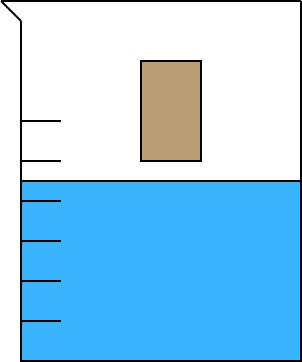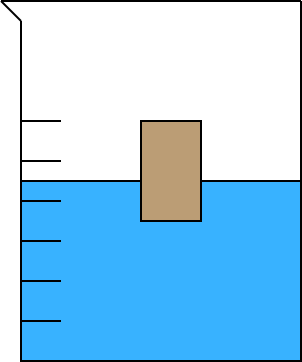

Illustration 1: The surface area is increased when an object penetrates the surface of a liquid
Introduction
We have discussed solids and liquids in general. We're now going to discuss the liquid phase in greater detail. We will discuss properties unique to liquids and how liquid properties can be related to the forces that hold liquids together. This is important because you can then relate these forces to the structure of the molecules of the liquid. This makes it possible to predict properties from things like Lewis structures!
The properties of liquids
We've learned several properties of the liquid phase:
Liquids are fluid - they change shape with the container they are put in. However, they do maintain a constant volume.
Liquids are dense - the molecules in a liquid are packed together more closely than in a gas.
Liquids are incompressible - you can increase the pressure on a liquid without much change in its volume.
There are some other properties unique to liquids. One is the boiling point, which was discussed at length in a previous note pack. Another is surface tension .
Surface tension
Surface tension is a measure of the tendency of a liquid to try to pull itself together so that the surface area is minimized. You notice this effect when you try to break the surface of a liquid. There is resistance, because for an object to penetrate a liquid surface, there must be an increase in the surface area as the liquid surrounds the object.
|
|
|
|
Illustration 1: The surface area is increased when an object penetrates the surface of a liquid |
|
You can observe surface tension in other situations as well. Consider a raindrop. Raindrops are rounded at the bottom and come to a point at the top. The roundness is caused by surface tension, since a sphere is the shape with the smallest surface area for a given volume. The point is caused by the raindrop's fall through the air - friction distorts the sphere until it comes to a point at the top.
Consider also what water does on a waxed car hood. When you wax a car, you coat it with a layer of material that water is not attracted to. Since there is less force pulling the water down on the waxed hood, then,. the water beads up and forms nearly spherical drops (which roll off the hood).
A third place to observe the effects of surface tension involves the phenomenon of capillary action . If you stick one end of a small glass tube into water, you'll notice an unusual thing happen - the water will be drawn up into the tube!
|
|
|
|
Illustration 2: Capillary action |
|
How do we explain this? First, water is attracted to glass. If we pour water out onto a flat clean glass sheet, we would observe that the water would form a sheet on the glass. (In the lab you can tell how clean your glassware is by observing whether the water forms a sheet on it.)
The attraction between glass and water tends to cause the water in the capillary to form a sheet on the inside of the capillary. So why does the middle fill up? Here's where we need surface tension. A large sheet of water has very little volume but a very large surface area. To minimize the surface area, water is drawn up the center of the capillary, filling it.
We can explain surface tension this way - surface tension is caused by attractive forces between the molecules in a liquid. These cause the liquid to draw itself together as much as possible, so that each liquid molecule is near as many other liquid molecules as possible. To push apart the liquid (break the surface), we must work against the attractive forces - and that requires energy.
Viscosity
Another property of liquids is the viscosity. You could also call viscosity the thickness of the liquid. We can define the viscosity as the resistance to flow of a fluid. Viscosity is not exclusively a property of liquids (there is such a thing as gas viscosity), but we will restrict our discussion to liquid viscosity.
What causes liquids to be viscous? What causes liquids to resist flow? We can explain viscosity by remembering that liquids are held together by intermolecular forces. When a liquid flows, molecules must move across each other. This involves moving against the (attractive) intermolecular forces. The liquid resists flow because the molecules don't want to move farther apart.
For long-chain molecules like many biomolecules, another factor comes into play. The long chains get tangled in each other, causing resistance to flow.
|
|
|
Illustration 3: 3D illustration of a decane molecule |
In molecules like decane, the molecule can rotate around the single bonds and become entangled with other molecules. This increases the resistance to flow of the liquid.
Intermolecular forces
We have discussed some properties of liquids. Each time, we have related these properties to something we called intermolecular forces. But what are these forces? The term intermolecular forces refers to any number of forces that exist between molecules. We will discuss three types of these forces in detail:
Dipole-dipole interactions
London dispersion forces
Hydrogen bonding
The first two are often collectively called van der Waals forces. All three of these forces are electrostatic - they involve charges.
Dipole-dipole interactions
The simplest of the three forces to understand is the dipole-dipole interaction . These attractions occur between polar molecules. Polar molecules have an uneven distribution of electrons around them. One end has more electron density than another, making the molecule have a slight positive charge (at the electron-poor end) and a slight negative charge (at the electron-rich end). Since opposite charges attract, the oppositely charged ends of polar molecules will attract each other.
The dipole-dipole interaction can be defined as an attractive force resulting from the attraction of the slightly charged ends of polar molecules to the oppositely charged ends of other nearby polar molecules.
Notes on dipole-dipole interactions:
They occur only in polar molecules .
They are relatively weak in comparison to the other forces.
The more polar a molecule is, the stronger these forces are.
London dispersion forces, or London forces for short
The London force is present in both polar and nonpolar species. To understand the London force, we have to consider where the electrons might be in a large molecule at any given snapshot in time.
|
|
|
|
Illustration 4: Cartoon drawing of a molecule |
|
So, on occasion, even a nonpolar molecule will have an uneven distribution of charge. Now, what happens to a similar molecule next to this unevenly charged molecule? A charge is induced on the other molecule, because its electrons will be attracted to the positive end of the first slightly charged molecule. This happens like a chain reaction. One molecule forms an instantaneous dipole and induces dipoles in surrounding molecules.
What happens when the electrons move around some more? The dipole flips, and the surrounding induced dipoles flip as well. This way, there is a net attractive force between the molecules.
The London force depends on how easy it is to form instantaneous or induced dipoles. As you might expect, larger molecules can form these dipoles more easily. Since larger molecules are usually heavier, we can say that London force increases with increasing molecular weight.
Notes on London forces:
They occur with any molecules - polar or nonpolar .
They are typically stronger than dipole-dipole interactions and weaker than hydrogen bonds.
The larger a molecule is, the stronger these forces are.
Hydrogen bonds
Hydrogen bonds are very important. While they occur only for a very limited set of molecules, these molecules happen to be extremely important to life on this planet. (Hydrogen bonds occur in water and nucleic acids, both important building blocks of life.)
We can define a hydrogen bond as an attractive force that can occur when a hydrogen atom bonded to a very electronegative atoms (like F, O, or N) interacts with a lone pair of electrons on an adjacent molecule . These hydrogen bonds are strong - almost as strong as a typical covalent bond. Let's take a closer look at the hydrogen bond:
|
|
|
Illustration 5: Hydrogen bonding in water |
In the diagram, the hydrogen bonds between the water molecules are represented as dotted lines connecting hydrogen and oxygen atoms.
How does a hydrogen bond form? When hydrogen bonds to a very electronegative element like O, N, or F, electrons are shared unevenly - just like in any other polar bond. Since hydrogen has only an n=1 shell (which fills with only two electrons), if electrons are pulled away from the hydrogen atom, the hydrogen nucleus is exposed. This hydrogen nucleus is an unshielded positive charge, and seeks to "protect" itself using any nearby electron source. The nearest electron source would be the lone pairs of O, F, or N on nearby atoms.
Notes on hydrogen bonds:
They occur only with molecules containing hydrogen directly bonded to O, N, or F. In addition, the O, N, or F must have lone pairs .
They are stronger (much stronger) than dipole-dipole interactions and London forces.
Forces vs. measurable properties
So how do these forces relate to the properties we have discussed? (A molecule can have one, two, or all three types of forces!) The stronger these forces, the more attraction the molecules have for each other.
The stronger the forces,
the higher the boiling point.
the greater the surface tension.
the lower the vapor pressure.
the more viscous the substance. However, viscosity also depends on the structure of the molecule.
So, in general a heavier species would have a higher boiling point, be more viscous, etc. than a lighter species.
If two species were similar in size and one was polar and the other one nonpolar, the polar one would have a higher boiling point, etc.
If a species hydrogen bonds, it will tend to have a much higher boiling point, etc. than a species that doesn't.
If you want to know something about the physical properties of the liquid state of a molecule, you should draw a Lewis structure and obtain the molecule's shape. Then determine what sort of forces are present. Is the molecule large or small (London forces)? Is it polar or nonpolar (dipole-dipole interactions)? Does the molecule hydrogen bond? If you know these things, then you know something about properties - without having to perform experiments!
Summary
In this note pack, we have discussed the liquid state and the properties of liquids. We introduced new liquid properties - viscosity and surface tension - and explained them in terms of intermolecular forces. We then described three types of intermolecular force - dipole-dipole interaction, London force, and hydrogen bond. We also related the strength of intermolecular force to the properties of molecules in the liquid state.
You should now be familiar with why liquids behave the way they do. It all comes down to the forces holding the liquids together.
All original site content ©2007 Charles Taylor. Page updated: December 12, 2007.